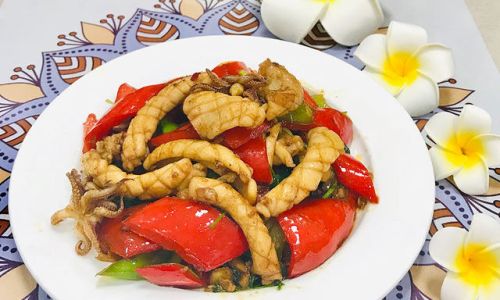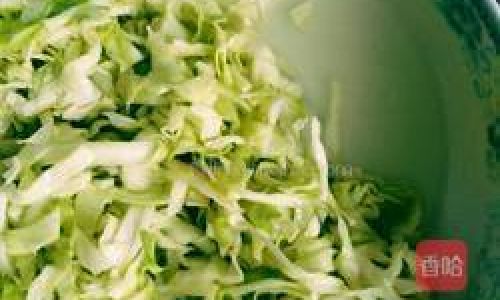Stir-fried squid, a dish celebrated in kitchens across Asia and beyond, is a testament to the magic of simple ingredients transformed by heat, skill, and a touch of culinary creativity. Often referred to as “爆炒鱿鱼” (bào chǎo yóu yú) in Chinese cuisine, this dish marries tender squid with a symphony of flavors—garlic, ginger, soy sauce, and a medley of vegetables—all cooked at blistering speeds to lock in freshness and texture. For home cooks and aspiring chefs alike, mastering stir-fried squid is a rite of passage, a skill that bridges tradition and innovation. This article delves into the intricacies of crafting this beloved dish, from selecting the finest squid to executing the perfect stir-fry, ensuring every bite is a harmonious blend of tenderness, crunch, and umami-rich sauce.

The Allure of Stir-Fried Squid
Stir-fried squid’s appeal lies in its versatility and accessibility. Whether served as a quick weeknight meal or the star of a banquet, it adapts effortlessly to diverse palates. In Chinese households, it is a staple during festivals and family gatherings, symbolizing abundance and joy. In Korean cuisine, it might be paired with gochujang for a spicy kick, while Thai cooks might incorporate lemongrass and basil for a fragrant twist. Yet, despite regional variations, the core principles remain consistent: tender squid, vibrant vegetables, and a glossy sauce that clings to every piece.
Selecting the Perfect Squid
The foundation of any great stir-fried squid dish begins with the squid itself. Freshness is non-negotiable. Look for squid with glossy skin, firm flesh, and a mild oceanic scent. Avoid specimens with dull coloration, a fishy odor, or slimy texture, as these indicate spoilage.
Fresh vs. Frozen: While fresh squid is ideal, frozen squid can be a reliable alternative if properly thawed. Opt for individually quick-frozen (IQF) squid, which retains texture better than bulk-frozen varieties. Thaw squid in the refrigerator overnight or under cold running water to prevent mushiness.
Species and Sizes: Common choices include Loligo (market squid) and Illex (flying squid). Smaller squid (4–6 inches) are tender and cook quickly, while larger ones may require longer cooking or tenderizing. For stir-fries, smaller squid is often preferred for its delicate texture.
Preparing the Squid: A Step-by-Step Guide
Proper preparation ensures tender, not rubbery, squid. Rushing this step can lead to a chewy texture, so patience is key.
-
Cleaning:
- Tentacles: Separate the tentacles from the body. Rinse under cold water, removing the beak (hard mouthpiece) located at the base.
- Body: Pull the head and innards away from the body. Discard the quill (transparent cartilage) inside.
- Skin: Gently peel off the purple skin using a knife or your fingers. This step is optional but enhances presentation.
-
Scoring:
- Lay the squid body flat and score the inner surface in a diamond pattern. This technique, called rangwan in Chinese, helps the squid curl attractively and absorb sauce.
-
Cutting:
Slice the body into 1.5–2 inch rings or strips. Keep tentacles whole or halve them if large.
-
Tenderizing (Optional):

Marinate squid in a mixture of baking soda and water (1 tsp per cup) for 30 minutes, then rinse thoroughly. This breaks down tough fibers but may alter flavor slightly.
Essential Ingredients and Flavor Pairings
The beauty of stir-fried squid lies in its adaptability. Below is a classic ingredient list, with suggestions for customization:
- Squid: 1 lb (450g), cleaned and prepared.
- Aromatics:
- Garlic (4 cloves, minced)
- Ginger (1 tbsp, julienned)
- Scallions (3 stalks, white and green parts separated)
- Vegetables:
- Bell peppers (1 cup, sliced)
- Onion (½ medium, thinly sliced)
- Carrot (½ cup, julienned)
- Sauce Base:
- Soy sauce (2 tbsp)
- Oyster sauce (1 tbsp)
- Shaoxing wine (1 tbsp)
- Sugar (1 tsp)
- White pepper (¼ tsp)
- Thickener:
Cornstarch (1 tsp mixed with 2 tbsp water)
- Oil:
Peanut or vegetable oil (2 tbsp)
Flavor Variations:
- Spicy: Add dried chili flakes or fresh bird’s-eye chilies.
- Tangy: Incorporate a splash of rice vinegar or lime juice.
- Herbaceous: Garnish with cilantro or Thai basil.
The Stir-Fry Technique: Mastering the Wok
Stir-frying is a high-heat, rapid-cooking method that requires precision and timing. A carbon-steel wok is ideal for its ability to retain and distribute heat evenly, but a large skillet can suffice.
-
Preheat the Wok:
Heat the wok over high heat until smoking. Add oil and swirl to coat.
-
Aromatics First:
Stir-fry garlic, ginger, and scallion whites for 10–15 seconds until fragrant. Avoid burning, which imparts bitterness.

-
Vegetables:
Add harder vegetables (carrots, onions) first, stir-frying for 1–2 minutes. Follow with quicker-cooking ones (bell peppers) for 30 seconds. Remove and set aside.
-
Squid:
- Return the wok to high heat. Add a touch more oil if needed.
- Stir-fry squid for 1–2 minutes until it curls and turns opaque. Overcooking will toughen the flesh.
-
Sauce and Finish:
- Pour in the sauce mixture and stir vigorously. Return vegetables to the wok.
- Add cornstarch slurry and toss until the sauce thickens (10–15 seconds).
- Fold in scallion greens and remove from heat immediately.
Common Pitfalls and How to Avoid Them
-
Rubbery Squid:
- Cause: Overcooking.
- Fix: Cook squid for no more than 2 minutes. Remove from heat once opaque.
-
Soggy Vegetables:
- Cause: Overcrowding the wok or uneven heating.
- Fix: Cook vegetables in batches if necessary. Ensure the wok is smoking hot before adding ingredients.
-
Bland Flavor:
- Cause: Insufficient seasoning or uneven sauce distribution.
- Fix: Taste and adjust seasoning before serving. Ensure the sauce coats all ingredients evenly.
Serving Suggestions and Pairings
Stir-fried squid shines when paired with contrasting textures and flavors:
- Rice: Steamed jasmine rice or fried rice.
- Noodles: Thin egg noodles or udon.
- Appetizer: Serve cold with a dipping sauce of soy, vinegar, and chili.
- Banquet Dish: Pair with other stir-fries, dumplings, and a clear soup.
Regional Variations
-
Korean Ojingeo Bokkeum:
Adds gochujang, gochugaru (chili flakes), and sesame oil. Garnished with sesame seeds.

-
Thai Pla Muek Pad Prik:
Incorporates lemongrass, basil, and fish sauce. Served with jasmine rice.
-
Spanish Calamares a la Romana:
Deep-fried squid rings with lemon wedges and alioli.
Advanced Tips for Perfection
- Velveting: Marinate squid in a mixture of egg white, cornstarch, and oil for 15 minutes before cooking. This technique, common in Chinese cooking, seals in moisture.
- Smoky Flavor: Use a torch to char scallion whites or garlic before stir-frying for a subtle smokiness.
- Plate Presentation: Mound the stir-fry on a platter, drizzle with chili oil, and sprinkle with toasted garlic chips.
Storing and Reheating Leftovers
Stir-fried squid is best enjoyed immediately, but leftovers can be stored in an airtight container for up to 2 days. Reheat gently in a wok with a splash of oil to revive texture. Avoid microwave reheating, which can toughen the squid.
Conclusion: The Joy of Stir-Frying
Stir-fried squid is more than a dish—it’s a celebration of culinary alchemy, where humble ingredients ascend to greatness through fire and finesse. Whether you’re a novice cook or a seasoned chef, mastering this recipe offers a gateway to understanding the principles of stir-frying: speed, heat, and balance. Experiment with flavors, embrace imperfections, and savor each tender, saucy bite. After all, in the world of stir-fries, there’s no such thing as perfection—only the pursuit of it, one blazing-hot wok at a time.
So, grab your apron, ignite the stove, and let the sizzling symphony begin. Your journey to stir-fry mastery starts now.





0 comments